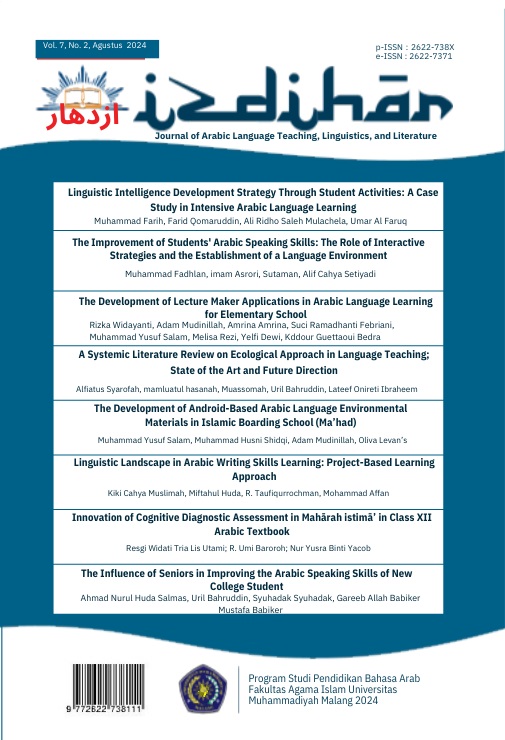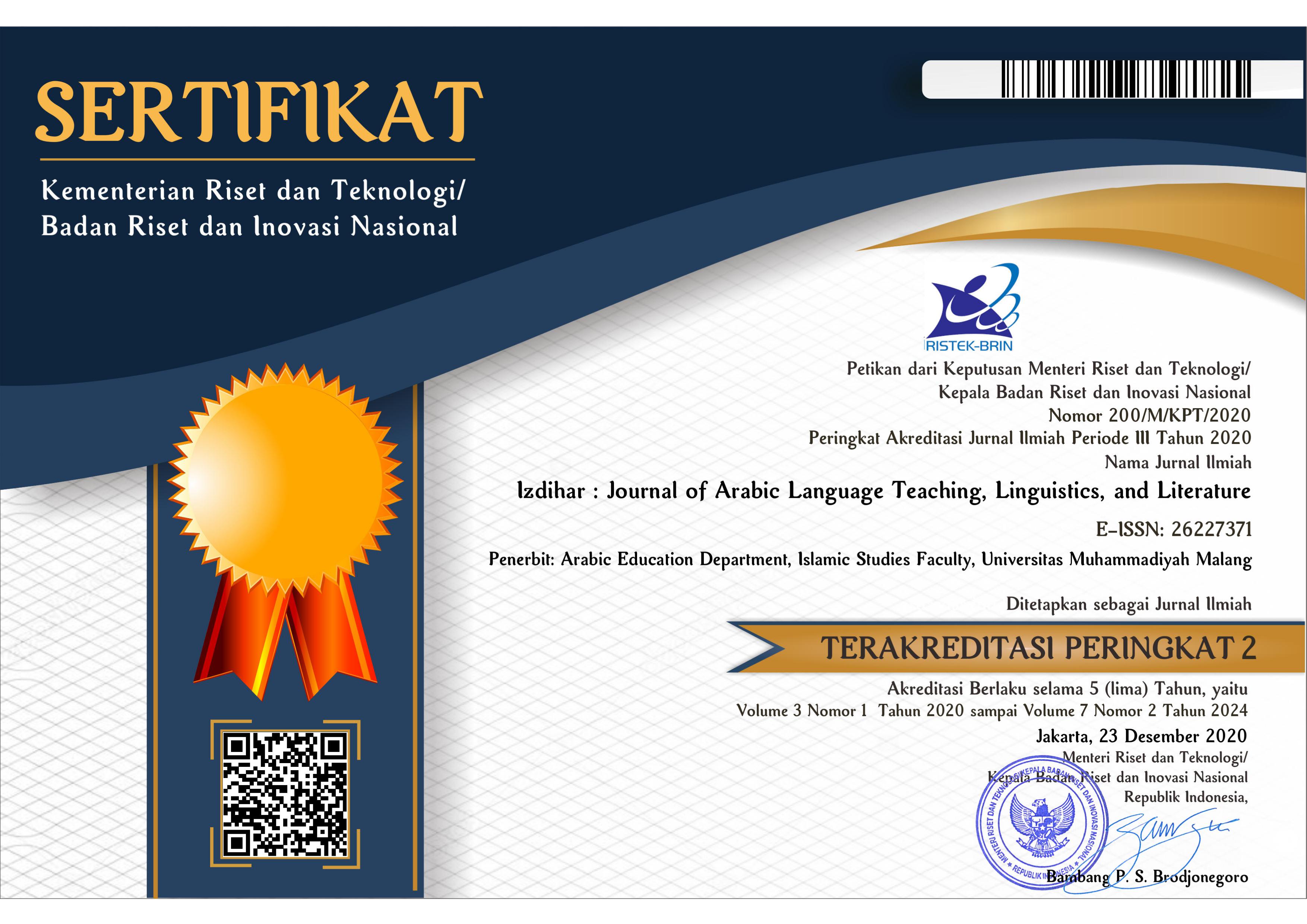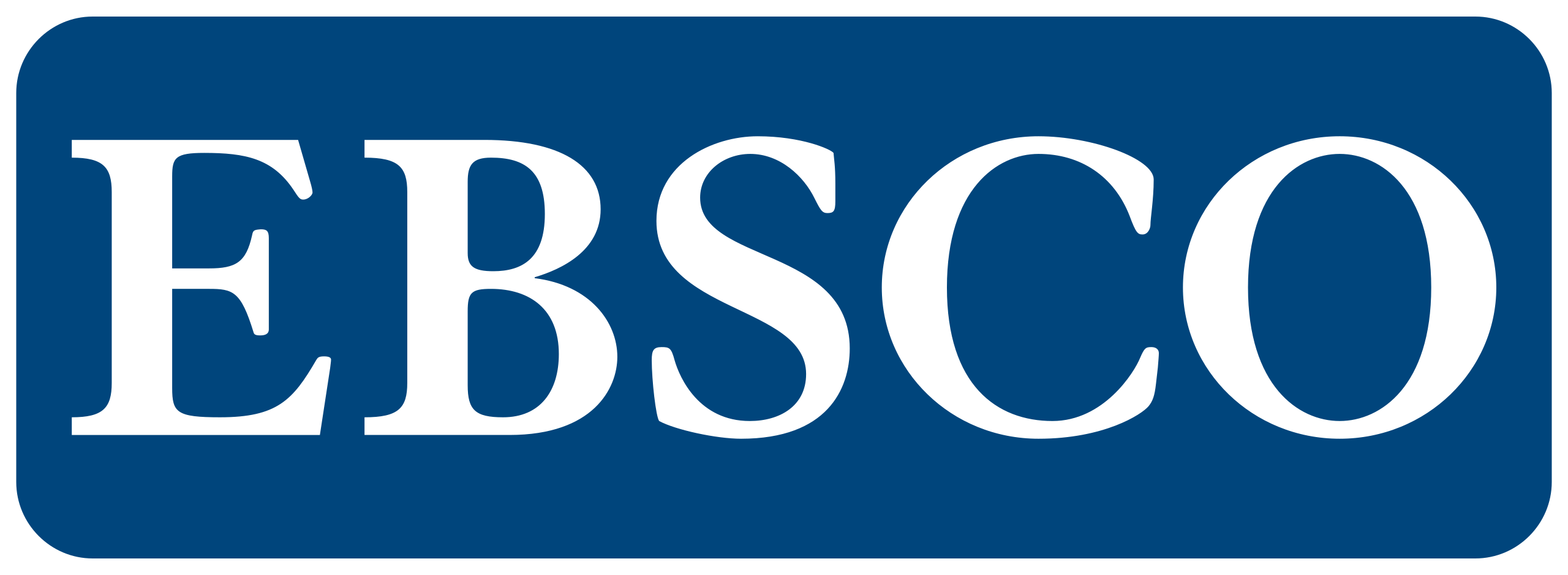Linguistic Landscape in Arabic Writing Skills Learning: Project-Based Learning Approach
DOI:
https://doi.org/10.22219/jiz.v7i2.31848Keywords:
arabic learning, arabic assessment, arabic, bahasa arab, tes formatif, Assessment Inovation, landscape linguistic, project based learning, maharah kitabahAbstract
This research aimed to describe linguistic landscape portrays its project-based learning model to be used a formative test in Arabic writing skills.. The researcher deepens the explanation of the learning stages in a project-based learning approach to create a linguistic landscape project of students' Arabic writing skills. The researcher also analyzed the forms of linguistic landscape projects that are the result of students' Arabic writing skills. The researcher opted to follow Miles and Huberman model which are data collection, data condensation, data display, and conclusion drawing. Therefore, observations, interviews, and documentations are used to collect the data. The conclusion found that Rusydi Ahmad Thu’aimah’s theory brought the level of the writing skills into intermediate level. The linguistic landscape, in a form of a flyer, underwent six synchronic stages of project-based learning. Then the linguistic landscape forms are used not only in the digital version but also in the hand writing version. The teacher offers various language skill models for all students.
Downloads
References
Ainin, M. (2007). Metodologi Penelitian Bahasa Arab. Malang: Hilal Pustaka.
Aminudin. Media Pembelajaran Bahasa Arab. Jurnal Al-Munzie. (2014). Vol.7 (2). 14. DOI: https://ejournal.iainkendari.ac.id/al-munzir/article/download/276/266
Arsyad, A. Media Pembelajaran. (2014). Raja Grafindo Persada Rineka Cipta.
Chanpet, P., Chomsuwan, K. & Murphy, E. Online Project-Based Learning and Formative Assessment. Tech Know Learn 25, 685–705 (2020). https://doi-org.sdl.idm.oclc.org/10.1007/s10758-018-9363-2
Cizek, G.J. (2009). An Introduction To Formative Assessment History, Characteristics, and Challenges at Handbook of Formative Assessments. Taylor & Francis e-Library.
Du, X., Lundberg, A., Ayari, M. A., Naji, K. K., & Hawari, A. (2022). Examining engineering students' perceptions of learner agency enactment in problem- and project-based learning using Q methodology. Journal of Engineering Education, 111(1), 111–136. https://doi-org.sdl.idm.oclc.org/10.1002/jee.20430
Guo, P., & Saab, N., & Post, L.S., Admiraal, W. (2020). A review of project-based learning in higher education: Student outcomes and measures. Elsevier: International Journal of Educational Research Vol. 102. 1. DOI: https://doi.org/10.1016/j.ijer.2020.101586
Hamalik, Oemar Hamalik. Kurikulum dan Pembelajaran. (2007). Bumi Aksara.
Handayani, & Rima, & Wulandari, D. (2021). Modern Assesment dalam Menyongsong Pembelajaran Abad 21 dan Hambatan di Negara Berkembang. Jurnal Pendidikan Edutama. 8 (1). 13. DOI: https://doi.org/10.30734/jpe.v8i1.1363
Handini, Nashihah, Khumairo, Yusuf. (2021). Situasi Kebahasaan pada Lanskap Linguistik di Masjid Tiban Malang. Insyirah: Jurnal Ilmu Bahasa Arab dan Studi Islam. Vol. 4 No. 2 Desember. 120. DOI: https://doi.org/10.26555/insyirah.v4i2.5349
Helm, J.H., & Kats, L. (2001). Young Investigators The Project Approach In The Early Years. Teacher College Press.
Hermawan, H., Siahaan, P., Suhendi, E., Kaniawati, I., Samsudin, A., Setyadin, A. H., & Hidayat, S. R. (2017). Desain Instrumen Rubrik Kemampuan Berkolaborasi Siswa SMP dalam Materi Pemantulan Cahaya. Jurnal Penelitian & Pengembangan Pendidikan Fisika, 3(2), 167 - 174. https://doi.org/10.21009/1.03207
Hugerat, M. How teaching science using project-based learning strategies affects the classroom learning environment. Learning Environ Res 19, 383–395 (2016). https://doi-org.sdl.idm.oclc.org/10.1007/s10984-016-9212-y
Landry, R., & Bourhis, R. Y. (1997). Linguistic Landscape and Ethnolinguistic Vitality: An Empirical Study. Journal of Language and Social Psychology. 16(1). 24. DOI:10.1177/0261927X970161002
Miles, M.B., & Huberman, A.M., & Saldana, J. (2014). Qualitative Data Analysis A Methods Sourcebook. SAGE Publications, Inc.
Moloeng, L.J. (2007). Metode Penelitian Kualitatif. PT Remaja Rosdakarya, 2007.
Nurhadiyati, A., Rusdinal, Fitria, Y. Pengaruh Model Project Based Learning (PjBL) terhadap Hasil Belajar Siswa Di Sekolah Dasar. Jurnal Basicedu Volume 5 Nomor 1 Tahun (2021). https://doi.org/10.31004/basicedu.v5i1.684
Nuryati, D. W., Masitoh, S., & Arianto, F. (2020). Pengaruh Project Based Learning Terhadap Kreativitas Peserta Didik di Masa Pandemi. Educate: Jurnal Teknologi Pendidikan, 5(2), 98–106. https://doi.org/10.32832/educate.v5i2.3375
Putry, H.M.E., & Muassomah M. (2021). TikTok application as a project based Arabic learning media, Alsinatuna: Journal of Arabic Linguistics and Education. Vol.7 No.2. 143. DOI: http://e-journal.iainpekalongan.ac.id/index.php/alsinatuna/article/view/3286
Rosnaeni. (2021). Karakteristik dan Asesmen Pembelajaran Abad 21. Jurnal Basicedu Vol 5. 4335. DOI: https://doi.org/10.31004/basicedu.v5i5.1548
Rosyid, M.Z. Ragam Media Pembelajaran. (2019). CV: Literasi Nusantara Abadi.
Sahidillah, M. W., & Miftahurrisqi, P. (2019). Whatsapp sebagai media literasi digital siswa. Jurnal Varidika, 31(1). 52-57. DOI: 10.23917/varidika.v1i1.8904
Sampurno, A. (2007). Penerapan Metode Belajar Aktif dan Pembelajaran Berbasis Proyek. PT. Rineka Cipta.
Sardjiyo. (2016). Optimalisasi Penggunaan Media Pembelajaran Sebagai Wujud Inovasi Belajar yang Bermakna dalam Pengembangan Karakter Peserta Didik. Prosiding Temu Ilmiah Nasional Guru (TING) VIII. 501. DOI: http://repository.ut.ac.id/id/eprint/6546
Sugiyono. (2016). Metode Penelitian Kuantitatif, Kualitatif, dan R&D. Alfabeta.
Syahril, Nabawi, R. A., Safitri, D. Students’ Perceptions Of The Project Based On The Potential Of Their Region: A Project-based Learning Implementation. Journal of Technology and Science Education, Vol 11, No 2 (2021). https://doi.org/10.3926/jotse.1153
Tarigan, H. G. (2008). Menulis Sebagai Suatu Keterampilan Berbahasa. Angkasa.
Taufik. Pembelajaran Bahasa Arab MI (Metode Aplikatif & Inofatif Berbasis ICT). (2011). PMN.
Taufiqurrochman, R. (2015). Leksikologi Bahasa Arab. UIN-Maliki Press, 2015), hal 11.
Tessmer, M. (1995). Planning and Conducting Formative Evaluation. Kogan Page Limited.
Thomas, John W. (2000). A Review of Research on Project-Based Learning. The Autodesk Foundation.
Umar, M. A. (2018). Penerapan Pendekatan Saintifik dengan Metode Pembelajaran Berbasis Proyek (Project-Based Learning) dalam Materi Ekologi. Bionatural: Jurnal Ilmiah Pendidikan Biologi, 4(2).
Wena. (2010). Strategi Pembelajaran Inovatif Kontemporer. Bumi Aksara.
Widiastuti, N.P.K., & Putrayasa, I. B., & Adnyana, K.S. (2022). “Instrumen Penilaian Keterampilan Menulis Siswa Sekolah Dasar”. Jurnal Pedagogi dan Pembelajaran. Volume 5, No.1. 53. DOI: https://doi.org/10.23887/jp2.v5i1.42473
Widiyanto, Hidayat. (2021). Teks Poster di Lanskap Linguistik Sekolah, Prosiding Seminar Nasional Linguistik dan Sastra (SEMANTIKS). DOI: https://jurnal.uns.ac.id/prosidingsemantiks/article/view/52940/32729
Wijaya, E.Y., & Sudjimat, D.A., & Nyoto, A. (2016). Transformasi Pendidikan Abad 21 sebagai Tuntutan Pengembangan Sumber Daya Manusia di Era Global. Prosiding Seminar Nasional Pendidikan Matematika. 1. 263-264. DOI: http://repository.unikama.ac.id/840/32/263-278
Yamin, M. (2004). Strategi Pembelajaran Berbasis Kompetensi. Gaung Persada Pers.
Zalzabilah, Z., & Julaikah, D. (2023). Penerapan Model Pembelajaran Kooperatif Concept Sentence Dengan Media Flashcard Untuk Keterampilan Menulis Kalimat Sederhana Bahasa Jerman Di Sman 2 Sidoarjo. Laterne. 12(02). 118-126. DOI: https://ejournal.unesa.ac.id/index.php/laterne/article/view/55108
Zhao, L., Zhao, B. & Li, C. (2023). Alignment analysis of teaching–learning-assessment within the classroom: how teachers implement project-based learning under the curriculum standards. Discip Interdscip Sci Educ Res 5, 13. https://doi-org.sdl.idm.oclc.org/10.1186/s43031-023-00078-1
Downloads
Published
How to Cite
Issue
Section
License
Copyright (c) 2024 Kiki Cahya Muslimah, Miftahul Huda, R. Taufiqurrochman, Mohammad Affan

This work is licensed under a Creative Commons Attribution-ShareAlike 4.0 International License.
Copyright Notice
Authors who publish with this journal agree to the following terms:
- Authors retain copyright and grant the journal right of first publication with the work simultaneously licensed under a Creative Commons Attribution-ShareAlike 4.0 International License that allows others to share the work with an acknowledgment of the work's authorship and initial publication in this journal.
- Authors are able to enter into separate, additional contractual arrangements for the non-exclusive distribution of the journal's published version of the work (e.g., post it to an institutional repository or publish it in a book), with an acknowledgment of its initial publication in this journal.
- Authors are permitted and encouraged to post their work online (e.g., in institutional repositories or on their website) prior to and during the submission process, as it can lead to productive exchanges, as well as earlier and greater citation of published work (See The Effect of Open Access).
Copyright (c) 2019 Izdihar : Journal of Arabic Language Teaching, Linguistics, and Literature

This work is licensed under a Creative Commons Attribution-ShareAlike 4.0 International License.


















